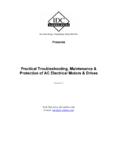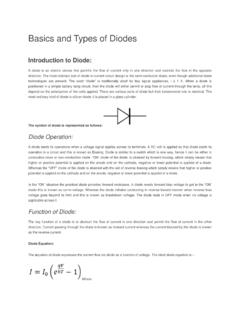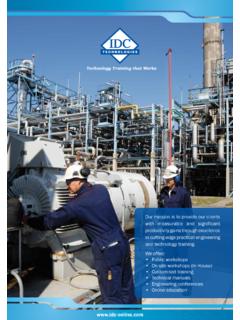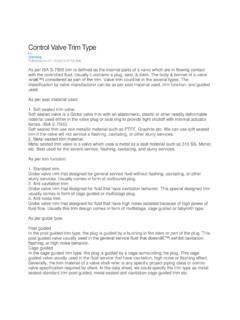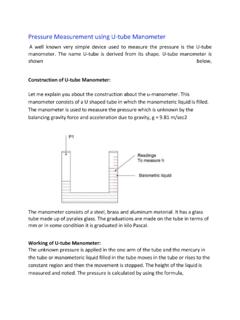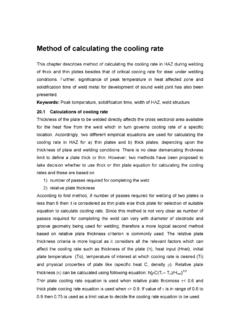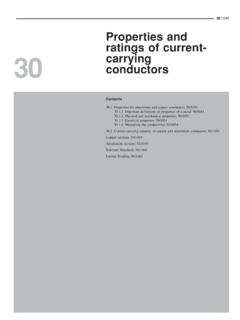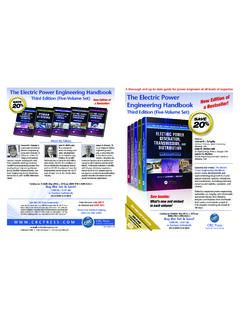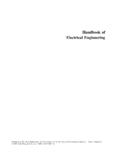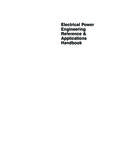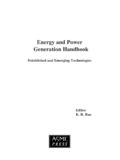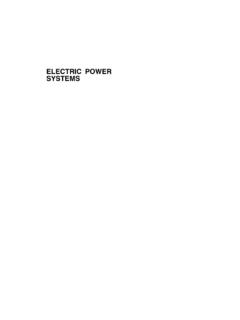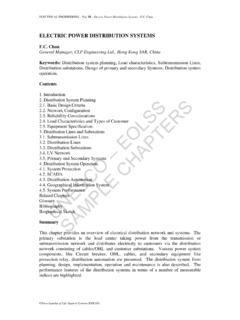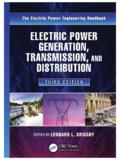Transcription of POWER SYNCHRONIZATION CONTROL OF VSC-HVDC …
1 International Journal of POWER System Operation and Energy Management ISSN (PRINT): 2231 4407, Volume-2, Issue-1,2 86 POWER SYNCHRONIZATION CONTROL OF VSC-HVDC TRANSMISSION FOR WEAK AC SYSTEM SEENA. K. R1 & 1,2 Dept. of electrical engineering , National Institute Of Technology Calicut, Kerala 673 601 E-mail : & Abstract- In this paper voltage source converter based hvdc transmission system is used for connecting two ac systems. The CONTROL method used is POWER SYNCHRONIZATION CONTROL . This method is different from other CONTROL methods and it uses the internal SYNCHRONIZATION mechanism in ac systems.
2 It is applied for all grid connected VSC s especially for hvdc application. This CONTROL method gives strong voltage support to a weak ac system. It shows that the proposed CONTROL allows POWER to be transferred from a system with short circuit ratio of to a system with an SCR of result is compared with the vector current CONTROL for the same ac system where it can transfer only The simulations in MATLAB/Simulink are done to demonstrate the system and observe the system behavior under three phase AC faults.
3 Keywords: hvdc , Voltage source converter, POWER SYNCHRONIZATION CONTROL , Short circuit ratio. I. INTRODUCTION High voltage DC transmission is a high POWER electronics technology used in electric POWER systems. It is an efficient, economic and flexible method to transmit large amounts of electrical POWER over long distances by overhead transmission lines or underground/submarine cables. Factors such as improved transient stability, dynamic damping of electrical system oscillations and possibility to interconnect two systems at different frequencies influence the selection of dc transmission over ac transmission.
4 The hvdc transmission based on voltage source converters (VSC) is a comparatively new technology, where the valves are built by IGBTs (Insulated Gate Bipolar Transistors) and PWM (Pulse Width Modulation) is used to create the desired voltage waveform Compared to conventional line commutated hvdc systems. The principal characteristics of VSC transmission are it needs no external voltage source for commutation, it can independently CONTROL the reactive POWER flow at each ac network and reactive POWER CONTROL is independent of active POWER CONTROL .
5 These features make VSC transmission technology very attractive for connecting weak ac systems, island networks, and renewable sources into a main grid. Two existing methods for CONTROL of VSC-HVDC are POWER angle CONTROL and vector-current CONTROL . POWER angle CONTROL is simple and straight forward to implement. In POWER angle CONTROL the active POWER is controlled by the phase angle shift between the VSC and the ac system, while the reactive POWER is controlled by varying the VSC voltage magnitude. The major disadvantage of POWER angle CONTROL is that the CONTROL system does not have the capability to limit the current flowing in to the converter.
6 [1] The vector current technology is the dominant CONTROL system for grid connected VSCs and it limits the current flowing in to the converter. The basic principle is to CONTROL the active POWER and the reactive POWER independently through an inner-current CONTROL loop. By using a dq decomposition technique with the grid voltage as phase reference , the inner current CONTROL loop decouples the current into d and q components. The d component of current is used to CONTROL active POWER or direct voltage, and the q component to CONTROL reactive POWER or alternating voltage.
7 The problems with vector CONTROL are the low-frequency resonance. This can interfere with the fast inner current CONTROL loop, thereby limiting the VSC CONTROL performance. All VSCs connected to the ac system uses a PLL to obtain an accurate SYNCHRONIZATION . But the PLL dynamics might have a negative impact on the performance of VSC-HVDC in weak ac-system connections. The POWER SYNCHRONIZATION CONTROL is the combination of POWER angle CONTROL and vector current CONTROL . In this no PLL is needed under normal system conditions.
8 The problems such as the resonant peak at grid frequency and converter over-current limitation are properly treated in the proposed CONTROL .[1] II. SYSTEM OUTLINE AND CONTROL VSC-HVDC main circuit diagram POWER SYNCHRONIZATION CONTROL of VSC-HVDC Transmission For Weak AC System International Journal of POWER System Operation and Energy Management ISSN (PRINT): 2231 4407, Volume-2, Issue-1,2 87 The schematic diagram of a VSC-HVDC transmission system connected between two ac systems is shown in ac source is a stiff constant frequency voltage source.
9 The mathematical model of the VSC-HVDC can be written as shown below.[2] 1ccfc cc cdiLv uR ij L idt (1) 1ffcgffduCiij C udt (2) (1) 1ggfg gg gdiLuE R ij L idt (3) Where Lc = The inductance of the phase reactor Rc =Resistance of the phase reactor E=Voltage vector of ac source uf=Voltage vector of filter bus v=Voltage vector across VSC Lg=Inductance of ac system Rg=Resistance of ac system P=Active POWER Q=Reactive POWER ic =Current vector of phase reactor ig=Current vector to the ac source 1 =Angular velocity of the ac system The short circuit ratio (SCR) is defined as the ratio of the short circuit capacity of the ac system at the filter bus and the rated POWER of the hvdc link.
10 AcdNSPSCR (4) Where Sac is the short circuit capacity of the ac system at the filter bus and PdN is the rated POWER of the hvdc link. Weak ac systems are those having SCR between and , whereas very weak systems have a value lower than The SCR can be regarded as an important reference for the design and operation of the hvdc system. It may cause the following problems in the hvdc system when connected to weak ac system: high temporary overvoltage, voltage instability, risk for harmonic oscillation and harmonic instability.

